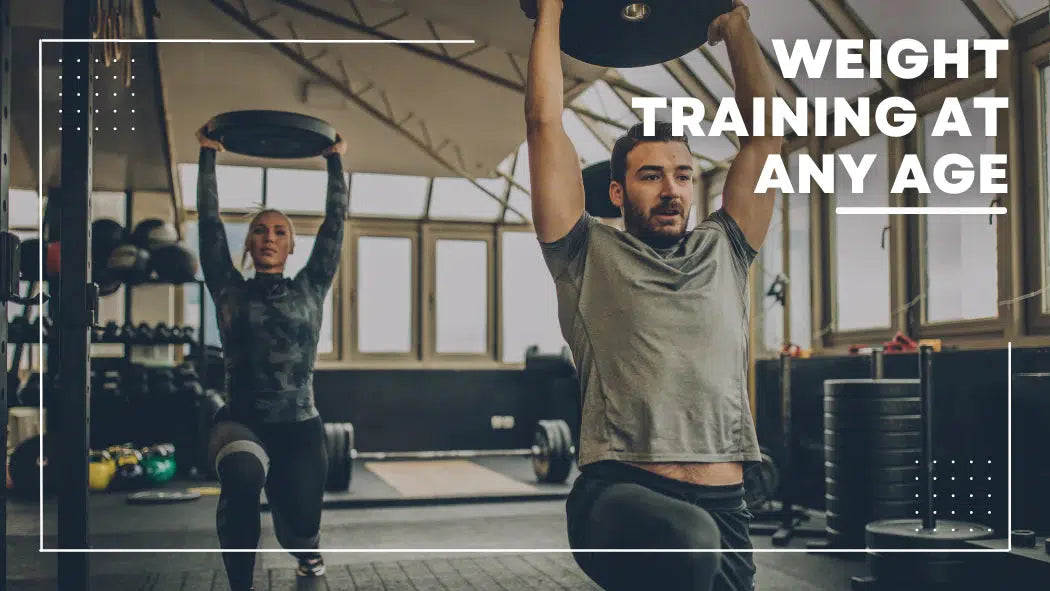
Weight Training at Any Age
Share
If you want to start a fitness regimen when you’re older, it may be intimidating to get started. You must figure out equipment, technique, and if you can even do it. When it comes to equipment, we can provide all the information you need. Regarding the rest, there’s good news. In short, no matter your age, you can begin a weight-training habit that will improve your life.
Weight training has many health benefits. In addition to boosting bone density, it also strengthens the muscles, ligaments, and tendons in and around your joints, making you stronger overall and less prone to injury. The risk of osteoporosis and other illnesses and diseases related to age, such as falls, is lowered. Weight training is more effective at reducing body fat and burning calories than aerobic exercise by boosting your metabolism for days after each workout. Furthermore, it improves flexibility more than other stretching methods.
In addition, strength training can help manage chronic conditions, sharpen your mental acuity, and bring a little pizzazz to your life through a sense of satisfaction.
Strength training may help prevent cardiovascular disease, decrease blood pressure, and reduce cholesterol levels by strengthening the heart and blood arteries. Moreover, moving furniture when it's time to vacuum or wrestling heavy packages into the car's boot is easier with additional muscle power.
Table of Contents
Strength Training Movements
There are some foundational movements and exercises that you can combine into sets to customise a workout to your comfort level. You can use different sizes of weights or everyday objects to increase your strength.

Carry - suitcase carry
Hold a dumbell, kettlebell, or rucksack in one hand (one that’s heavy but not overwhelming to you) and walk a few metres. Then switch hands and walk back. Brace your core to stay upright; if you need to, keep your other arm out for balance.
Hip hinge - kettlebell swing
Bring a kettlebell or dumbbell up to chest height by bending your knees slightly, straightening up and driving your hips forward. Avoid doing any exercises that involve squatting or front raises.
Horizontal pull - bent row
Maintaining a straight back at an angle of roughly 45 degrees from the vertical, "row" the weight to your ribs by drawing your elbows behind you and tucking them in. Always ensure the load is modest enough that you may halt briefly at the peak of the motion.
Horizontal push - press up
Start with your hands squarely under your shoulders, maintain a plank posture with your body, tuck your elbows to your sides to prevent joint tension, and touch your chest to the floor at the bottom of each "rep" (repetition). Start with your hands on a stair, couch, or wall if you can't do one repetition. (Knee press-ups, a common substitute, aren't an excellent technique to build up to the full version since they don't fully engage your core.)
One-legged movement - reverse lunge
Take a large stride backward from a standing position, bending your leading knee until your following knee almost touches the ground. Once you're back on your feet, switch to the other leg and repeat. You may add resistance by holding a hex weight, a rucksack full of books.
Squat - goblet squat

Keep your weight on your heels as you squat with the dumbbell in front of you, like you're holding a medieval goblet, and bend at the elbows to bring your upper body closer to the floor. By stopping for a few seconds at the bottom of the action, you'll improve strength and mobility without falling into the forward lean that bothers many barbell squatters.
Vertical pull - pull up
Pull-ups or chin-ups - which are differentiated by whether your hands are facing inward or out – are a challenging move that you likely won’t achieve on the first try. Several bars can be clipped safely into a door frame, to try at home if you don’t have a rack. To do "negatives," start by jumping so that your chin clears the bar, then lowering yourself as slowly as possible.
Vertical push - dumbbell press

If you can't yet do handstand press-ups, dumbbell presses are the next best thing; they're easy on the shoulders and can be done with anything from kettlebells to soup cans. To do a straight-arm overhead press, start with the weights at your shoulders, brace your core, and lift in one fluid motion, allowing your hands to rotate as they go. Adopt a measured approach to build up strength.
How to Combine Movements into Workouts
The first thing to do when you want to carry out a weight training session is to decide your goals. Do you want to get stronger? Lose weight or just tone up? Here are some tips:
-
You don't have to become a powerlifter to see improvements in your health. However, if bulking up is your goal, you must regularly increase your exercise volume (volume = weight x repetitions x sets) and the level of weights you are using.
-
It is essential to have a high metabolic rate if you are trying to shed excess pounds. Keeping your heart rate up might entail performing some kind of cardio or some sort of circuit training. Combining weights into HIIT routines (High Intensity Interval Training) is a popular way of working out to achieve both muscle definition and lose body weight.
-
Increasing the intensity of your exercises (by accelerating your repetitions, making the exercise more difficult, or doing more of them) while maintaining a high-calorie burn rate can help you grow leaner and more toned over time.
Tips on Building Your Workout Session
Prioritise complex workouts, which involve using many muscular groups in a single movement (like squats, deadlifts, and bench presses). These are the most effective moves so try to use these in every session.
Move on to your auxiliary or accessory motions and isolating exercises (which only work one muscle group) (the ones that support everything else). This is focusing on one area at a time such as arms, legs or core.
As a beginner, start with a weight that’s not too challenging to lift. Stick to one or two sets at a time. You can increase the weight and sets as you get used to these.
Tools for Weight Training At Home

-
Dumbbell set with rack to support you at every level as you build strength
-
Resistance bands that challenge each exercise and allow you to master your form.
Frequently Asked Questions
How often should I work out?
Beginners should aim for 2 to 3 times a week.
What are "sets" and "reps"?
The term "reps" refers to the number of times an exercise is performed before a break is taken. Simply put, sets are collections of repetitions. In other words, 20 press-ups total (ten at a time, followed by ten after a pause) is considered two sets of 10 repetitions.
How much weight should I be using?
Just enough so that you have to work to complete each move, but not so much that you feel like you're "grinding." Each repetition should be performed at a constant pace; if the pace drops, the set is over. If your goal is to gain muscle mass rather than strength, continuing until you can’t is the way to go.
If I want to get in shape, how many sets should I do?
Although there is some overlap, the basic guideline is that increasing the weight until you can complete one to five repetitions improves pure strength, five to 12 reps aid with muscle, and anything above 12 reps builds muscular endurance. There's no harm in doing repetitions until your pace slows down if you're using light dumbells or a resistance band (see above).
Can you recommend a good amount of downtime?
The answer to this question is, once again, goal-specific: weightlifters trying to do one or two repetitions at a near-maximum weight could rest for five minutes between sets, while those exercising to lose fat should rest for less than a minute. The sweet spot, at around 90 to 120 seconds, is best for building strength and muscle.
Ready to Get Started?
The fact that you’ve read this far means you’re interested in optimising your health and strength through weight training. Consider your main goals, invest in the tools you need to achieve them, and plan your workouts. Avoid being too complex with your routines at the beginning, but have a strategy in mind and remember to enjoy your routines. The main goal is to remain consistent and with consistency you will see success.
If you enjoyed this article, you might also like the following:
Get Stronger with Dumbbells: Workouts for Men 40+
